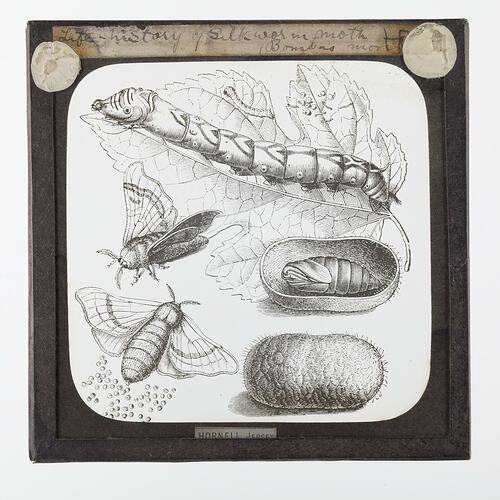Summary
Due to its small size and ease of cultivation, the silkworm (Bombyx mori) has long been recognised as a model organism for the study of lepidopteran and arthropod biology. Fundamental findings on pheromones, hormones, brain structures, and physiology have been made through studies of the silkworm. Throughout the 20th century raising silk worms and observing their life cycle was a popular classroom science experiment in many Australian primary & secondary schools due in part to its relatively short life cycle duration of 6-8 weeks.
Glass lantern slides, often sold in sets and used with a magic lantern type projector, became a popular adjunct for public lectures, talks and teaching purposes from the 1880s and were readily available by the end of the 19th century, both through mail order catalogues, wholesalers and retail photographic and scientific supply shops. The manufacturer of this slide identified by an adhesive label sealed under the cover glass, which reads 'HORNELL, JERSEY'.
James Hornell (1865-1949) was a supplier of natural history specimens and educational materials including microscope slides, lantern slides and mounted specimens.
After studying zoology, at University College, Liverpool, where he developed an interest in marine biology and oceanography, James Hornell married Charlotte Sinel on 29th September 1891. His father-in-law Joseph Sinel (1844-1929), had been born in St Helier, Jersey, in the Channel Islands, were he began his career in a furniture shop and was subsequently promoted to manager before quitting his job, in 1883, to fulfill a life-long ambition of establishing a natural history business. Operating initially under the title Sinel & Co. early activities of the business included taxidermy, the preservation and mounting of specimens of sea life, and the production of prepared microscope slides and related educational materials aimed at the growing interest in microscopy amongst amateur scientists, scientific societies and natural history clubs, and through the teaching of science and scientific observation methods in schools, universities and museums. Hornell joined Sinel as a partner in November 1892, with the firm becoming Sinel & Hornell, and together they founded the Jersey Biological Station in 1893, which consisted of public aquarium displays and rentable laboratory space for visiting scientists, as an adjunct to their production facilities. They also established a magazine, the Journal of Marine Zoology and Microscopy, subtitled "a plainly worded biological quarterly". Sinel left the partnership to follow other entrepreneurial opportunities during the winter of 1894-95, and Hornell then continued the business of making slides, preserving specimens, operating the aquarium, and managing the journal. He also began two subscription schemes, through which subscribers regularly received a set of slides and a booklet with photomicrographs and descriptions of the specimens. There were two series, Microscopical Studies of Marine Zoology (begun in 1893), and Microscopical Studies in Botany (begun in 1895). After a promising start with strong interest, the aquarium later faltered as other aquaria were opened on the English mainland. In 1899, Hornell transformed the space into The Pure Mineral-Water Company, before selling the business entirely in late 1901. Leaving Jersey, he joined an old university associate, Professor Herdman, to examine and report on the pearl fisheries of Ceylon, where Hornell remained for six years. In 1908, he was invited to undertake a reorganisation of the Madras Fisheries, and was subsequently appointed as Director, holding the position until retirement in 1924. After retiring he travelled extensively and returned to an earlier interest in the study of maritime craft, which led to his inclusion in the St George Expedition to the South Seas in 1924-1925. A major outcome of the expedition was his compilation, in association with A. C. Haddon, of the comprehensive work 'The Canoes of Oceania', published in in three volumes by the Bishop Museum in Hawaii.
Description of Content
Illustrations of nine life stages of the Silkworm Moth (Bombyx mori), from eggs to egg-laying adult female moth, on background of mulberry leaf.
Physical Description
Standard format (3¼ x 3¼ inch square) glass lantern slide, with printed black & white image, with internal round-cornered black paper mast, bound by black tape around edge.
More Information
-
Collection Names
-
Collecting Areas
-
Acquisition Information
Transfer from Natural History Division, Museum of Victoria, 01 Jun 1990
-
Manufacturer
James Hornell (Jersey Biological Station), Jersey, Channel Islands, circa 1895-1899
-
Format
Lantern Slide, 3¼ in. x 3¼ in., Black & White
-
Language
English
-
Inscriptions
Handwritten inscription on border: 'Life - history of Silkworm moth (Bombyx mori)'
-
Classification
-
Category
-
Discipline
-
Type of item
-
References
Brian Stevenson (2018), 'Joseph Sinel, 1844-1929 / James Hornell, 1865-1949', [Link 1] updated October 2018, viewed 17/07/2020. 'Obituary: James Hornell, 1865-1949', The Journal of Polynesian Society, vol.58, no.3, 1949, p.132, [Link 2] viewed 21/07/2020.
